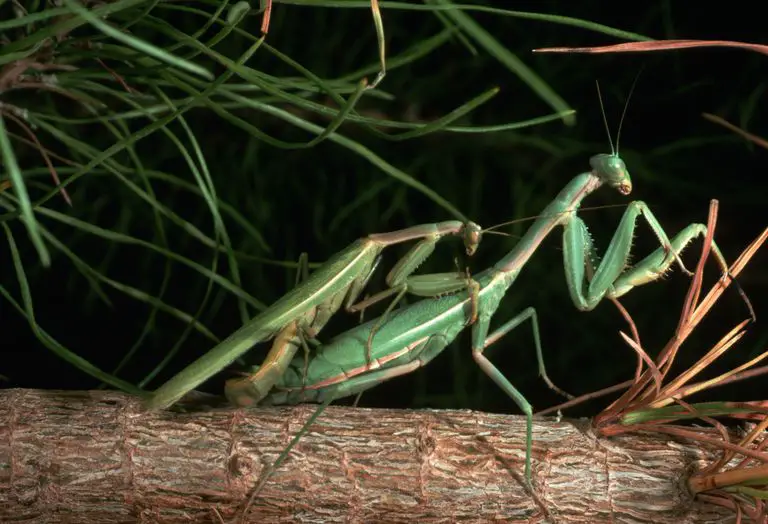There’s no denying that praying mantis demonstrates cannibalism particularly in mating. That is to say that female mantis consumes her mating partner right after the mating. However, the sexual cannibalism is just a little too complex as females don’t always eat the male. They are probably either too hungry to feed on their partner or perhaps eating males may actually benefit them reproductively. Let’s see in detail why do praying mantis eat their mates.
Why does the Female Praying Mantis Eat the Male? – Do Praying Mantis Eat their Mates?
The female praying mantises are pretty infamous for regurgitating their males but that isn’t the rule of thumb. Scientists have found out that only one out of every forty five mating ends up in cannibalism; most of the times the female eats the male but sometimes it’s the other way round. About one-fourth of the mating ends up in the death of the male.
READ: Praying Mantis Life Span – How Long Do Praying Mantis Live?

However the case maybe, the cannibalism does appear to benefit females in one way or the other. According to the latest findings Proceedings of the Royal Society B, females actually lay more eggs when they eat their mating partner as compared to when they don’t.
The female first bites off the male’s head followed by its body parts. If the male is bigger in size then it probably assists the female in laying greater number of eggs. In order to prove it scientifically, researchers feed captive mantises crickets but each cricket is tagged with radioactive labels so they could identify each of them individually. Moments later, males and females were paired off to see if they eat each other. Researchers found out that the females which consumed their mating partner produced as many as 51 eggs—25% more than the average size of the clutch.
Related articles:
- Do Praying Mantis Eat Plants?
- How Do Praying Mantis Eat?
- What Do Praying Mantis Eat? – Praying Mantis Diet & Eating Habits
- Do Praying Mantis Die After Laying Eggs?
Females are more likely to cannibalize smaller males but sometimes they even consume their partner before mating. Once the pair finishes off mating, the male appears to be nothing more than a decent meal for a female. Nonetheless, scientists still believe most females do not fancy eating males and only 30% of mating ends up in cannibalism.
According to a research, male mantises will be attracted towards a female that isn’t only less aggressive but also less starving so as to get away with their cannibalistic attitude. Mating with skinny females mostly, if not always, comes with the heavy price for males.
“When a female ate a male after a mating event, she was found to have around 17.7 per cent more of his biological material in her reproductive tissues, including her eggs and ovaries, than a female who only mated and did not cannibalise her mate,” explained lead researcher Kate Barry, a biologist at Macquarie University in Sydney.
Probable Reasons behind Female’s Cannibalism
Apart from evolutionary reasons scientists believe that females feed on their males because they’d probably like to have better food one that helps them live longer lifespans and look after their young. Or perhaps the female might fancy giving birth to ‘fitter’ offspring. Kate also believes that not all males are eaten by the females. As a matter of fact, 80% of males get away with cannibalism. That being said, more research needs to be done so we get to know precisely as to why females consume males in one situation and not the other.
But it is up to the female if she wishes to take on her mating partner. The female’s overall condition of her body as well as her eager to feed on males primarily determines the cannibalism behavior. The biologist also added that male mantids prefer to mount on the female from her back whilst approaching gradually so as to avoid her eating them.
Why does the Female Praying Mantis Eat the Male? – Video
References
“Do Female Praying Mantises Always Eat the Males?”. Entomology Today. 22 December 2013. Retrieved 31 July 2015.
Liske, E.; Davis, W. J. (1987). “Courtship and mating behaviour of the Chinese praying mantis, Tenodera aridifolia sinenesis”. Animal Behavior. 35: 1524–1537. doi:10.1016/s0003-3472(87)80024-6.
Lelito, Jonathan P.; Brown, William D. (2006). “Complicity or conflict over sexual cannibalism? Male risk taking in the praying mantis Tenodera aridifolia sinensis”. The American Naturalist. 168 (2): 263–269. doi:10.1086/505757. PMID 16874635.
Leave a Reply